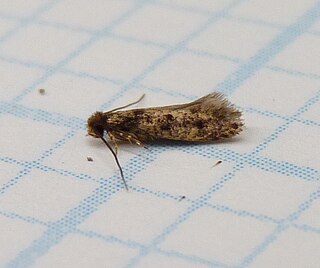
The evergreen bagworm, commonly known as bagworm, eastern bagworm, common bagworm, common basket worm, or North American bagworm, is a moth that spins its cocoon in its larval life, decorating it with bits of plant material from the trees on which it feeds.

The Psychidae are a family of the Lepidoptera. The bagworm family is fairly small, with about 1,350 species described. Bagworm species are found globally, with some, such as the snailcase bagworm, in modern times settling continents where they are not native.

Microlepidoptera (micromoths) is an artificial grouping of moth families, commonly known as the 'smaller moths'. These generally have wingspans of under 20 mm, and are thus harder to identify by external phenotypic markings than macrolepidoptera. They present some lifestyles which the larger Lepidoptera do not have, but this is not an identifying mark. Some hobbyists further divide this group into separate groups, such as leaf miners or rollers, stem or root borers, and then usually follow the more rigorous scientific taxonomy of lepidopterans. Efforts to stabilize the term have usually proven inadequate.

Tineoidea is the ditrysian superfamily of moths that includes clothes moths, bagworms and relatives. There are six families usually included within it, Eriocottidae, Arrhenophanidae, Lypusidae, Acrolophidae, Tineidae and Psychidae, whose relationships are currently uncertain.
The wattle bagworm is a species of moth in the family Psychidae. In southern Africa it is a pest of the black wattle which is grown largely as a source of vegetable tannin. Kotochalia junodi is indigenous to Southern Africa, where it originally fed on indigenous relatives of the wattle.
Fangalabola is a species of bagworm moth native to Madagascar.
Eumeta crameri is a bagworm moth of the family Psychidae. It was described by John O. Westwood in 1854 and has worldwide distribution in tropical and subtropical habitats, including India, Bangladesh, Sri Lanka, New Zealand and Puerto Rico.

The Coleophoridae are a family of small moths, belonging to the huge superfamily Gelechioidea. Collectively known as case-bearers, casebearing moths or case moths, this family is represented on all continents, but the majority are found in temperate areas of the Northern Hemisphere. They are most common in the Palearctic, and rare in sub-Saharan Africa, South America, and Australia; consequently, they probably originated in northern Eurasia. They are relatively common in houses, they seek out moist areas to rest and procreate.

Psyche casta is a nocturnal moth from the family Psychidae, the bagworm moths. The wingspan of the males ranges from 12 to 15 millimeters. They have hairy, brown-metallic shiny wings. The grub like females have legs but do not have wings and are yellowish or light brown, except for some dark brown back plates. They remain in the case.

The large birch bright is a small nocturnal moth from the bagworm moth family (Psychidae). It is found locally in Europe, from southern Scotland, through west and central Europe, east up to Russia and the Balkans. In the north it is found in Fennoscandia. In mountainous areas it is found up to heights of 1,800 meters ASL.

Phereoeca uterella is a species of moth belonging to the family Tineidae. It is commonly known as the plaster bagworm but as the term "bagworm" more properly refers to moths of a different family (Psychidae), it is often called the household casebearer – which may in turn refer to the related Phereoeca allutella. It is found in warm, humid climates throughout the Americas although the exact range is difficult to map as it is easily confused with other case-bearing tineids. It is common in houses.

Tinea pellionella, the case-bearing clothes moth, is a species of tineoid moth in the family Tineidae, the fungus moths. It is the type species of the genus Tinea, which in turn is the type genus of the subfamily, family, as well as the superfamily Tineoidea. Its scientific name is derived from "tinea", a generic term for micromoths, and the Latin term for a furrier, pellionellus. Another common name is "bagworm" due to the case that their larvae carry around, but not to be confused with the Psychidae that are also called "bagworms" in English.

Apterona helicoidella is a moth of the Psychidae family. It is widely distributed in Europe, from Portugal through most of central Europe and the Alps, up to the Ural. It is also found on the Balkan and in Turkey. It was introduced in the United States by accident during the 1940s. It is now found in many mid-Atlantic states, including Pennsylvania, and has also been reported in the Pacific coastal states, as well as Colorado, Michigan, Nevada, Utah and Idaho. It has been collected in Ontario as well.
Phereoeca allutella, the household case-bearing moth, belongs to the subfamily Tineinae of the fungus moth family (Tineidae). It was first described by Hans Rebel in 1892. It is an occasional pest of furs, flannel and similar materials, and has been inadvertently introduced to many places it is not originally native to.
Sapheneutis pulchella is a species of bagworm moth native to eastern Madagascar.
Typhonia bimaculata is a species of bagworm moth native to Madagascar.
Lepidosaphes gloverii is a species of armored scale insect in the family Diaspididae.
Eumeta variegata, the paulownia bagworm, is a moth of the family Psychidae. The species was first described by Snellen in 1879. It is found in Japan, Papua New Guinea, India, the Solomon Islands and Sri Lanka.
Cryptothelea is a genus of moths belonging to the family Psychidae.










